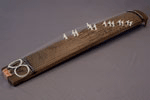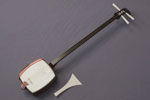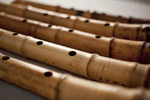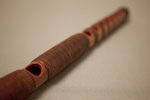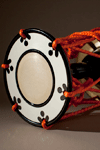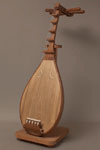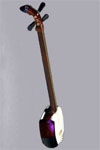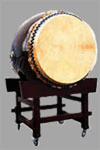
KOTO
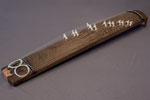
The koto, a type of Japanese zither, is the most popular Japanese musical instrument. The character [琴], read as ‘koto’, is used to refer to the Japanese zither.
The koto was introduced from China, and as a standard, has 13 strings. Aside from the standard 13 string koto there is also a 7 string kin (chinese “qin”) and a 6 string koto called yamatogoto or wagon.
In general, 13 strings of the same thickness are used, and mobile bridges called kotoji are arranged under the strings for tuning with the instrument tuned in accordance with the piece of music to be played. The koto is played with tsume, small plectra or picks, attached to three fingers on the right hand. In gagaku, traditional Japanese court music, the koto was played as part of an ensemble, after that, as an accompaniment for temple ballads, and actively came to be performed solo during the Edo period (1603-1868).
Yatsuhashi Kengyo is widely recognised as the founder of modern koto. Two distinct traditions of koto, the Ikuta school and the Yamada school, also exist. The koto actively features in ensembles with shamisen, a type of traditional Japanese lute, and shakuhachi, a traditional Japanese bamboo flute (and at one time also the kokyu, or Japanese fiddle). Since the Meiji Era (1868-1912), a steady stream of new koto pieces have been produced. Following the Taisho period (1912-1926), the 17 string bass koto, the 20 string, 25 string, and 30 string koto that further broadened the range, were also created.
Music Library
- Chidori no kyoku
(Song of plovers) - Kengyō Yoshizawa
(1801 or 1808-1872) - about
1855 - play
- Tuned to kokinjōshi. A piece from the end of the Shogunate, yet spread all over the country through the Meiji period and is still loved today. Composed of Mae-Biki, Mae-Uta, Tegoto, Ato-Uta. Generally played together with shakuhachi, traditional Japanese bamboo flute, however, the original piece was for an ensemble of koto and kokyu, Chinese violin/fiddle.
- Mizu no hentai
(Transformation of water) - Michio Miyagi (1894-1956)
- 1909
- play
- The composer's debut piece, composed at the age of 14. While conforming to the techniques of old, individuality is infused in the scene depiction. The lyrics are 7 waka, Japanese poems, from a Japanese language schoolbook, with the piece so famous in Japan that it is learned in primary school class. It depicts the various transformations of water, such as rain and snow. The composer was a pioneer of the modernisation of traditional Japanese music, contributing both a large number of music pieces and the reformation of instruments.
- Sanka
(Song of praise) - Tadao Sawai (1937-1997)
- 1978
- play
- A song in praise of nature, people and arts. The piece is by famous koto player Tadao Sawai, also renowned as a composer. Along with leaving behind a large number of pieces making use of modern playing technique, he also strove to foster the development of younger musicians.
- Kōru
- Shinichiro Ikebe (1943-)
- 1977
- play
- under construction
Performance by Sachiko Yoshihara
In each episode, when staff notation is applicable, it is standardized by absolute pitch notation.






















